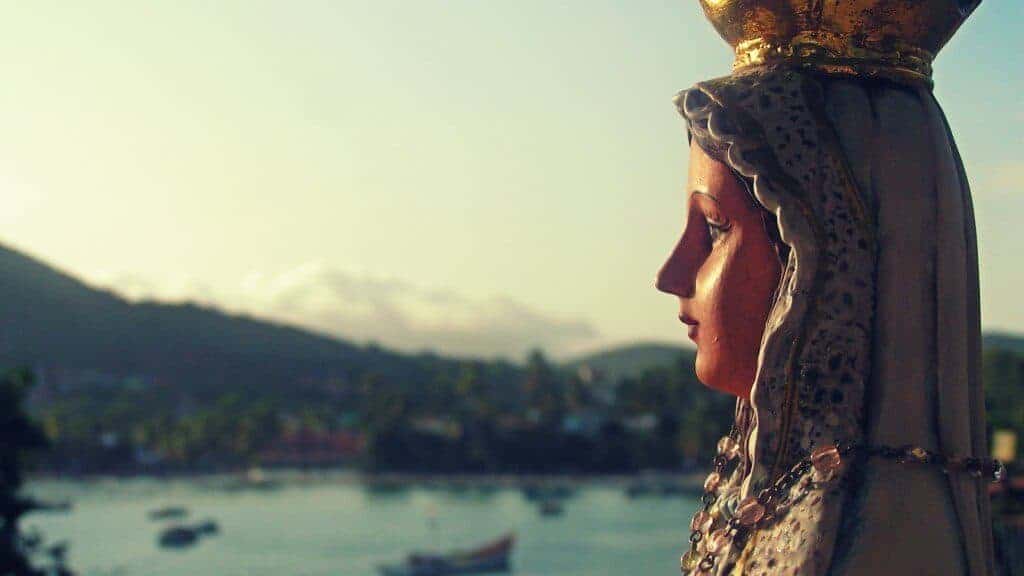Miraculous Virgin, Patroness of the East and the Venezuelan Navy, Mother of Fishermen, Defender of the Neo-Spartans, every year, on September 8, the people of Margarita, the State of Nueva Esparta and the East of the national honor her.
Virgin of the Valley – History and Miracles of the Virgin of the Valley
They put on their spiritual garments to join the pilgrimage of tens of thousands of parishioners who joyfully celebrate the “Bajada de la Virgen” (Descent of the Virgin) and give thanks for the miracle performed by their Queen Mother.
The moment in which all these pilgrims arrive to worship Mary in her temple in El Valle, municipality of Garcia, Venezuela.
According to many of the faithful, religious heritage has been transmitted from one generation to another. The elders of El Valle remember that their mothers instilled in them the love for the Virgin and that it is “divine law” for the easterners to have an altar of the Virgin in their homes.
The festivities last several days, during which the Virgin can be seen wearing various costumes made from materials donated by her devotees.
Virgin of the Valley
The Virgin of the Valley is the oldest immaculate image of the Mother of God in the American continent, whose figure arrived in Cubagua, at a time when the Guaiqueríes were imploring for a miracle that would put an end to the barbarism of the Spaniards against their race.
It was when these natives asked Spain to send them an image of the Immaculate Conception to worship in one of the temples that were being built in Nueva Cadiz (the first Spanish city founded in South America, located on the island of Cubagua).
This place had a boom in commerce due to the extraction of pearls, since they were abundant in its seas.
The story goes that an anonymous Spanish artist, from the VI century, modeled in wood her angelic face, arms and hands, as a harmonious representation of “La Purisima”.
Her elements were supported with ribbons of the same material, to give her the appearance of the Immaculate Conception, the mother of Jesus.
It was the year 1529 when a galleon was taking her to Santo Domingo, the former island of Hispaniola, but Providence made that, upon arriving at the port of Cubagua, she sanctified the first European settlement in America, to give comfort to the native Guaiqueríes in the shadow of her Hermitage.
On December 25, 1541, when the parishioners of Cubagua celebrated the birth of Jesus in the chapel of its Patron Saint, the church raised its prayers to heaven to praise the Almighty.
The Virgin of the Valley, who arrived in Cubagua at a time when the Guaiqueros were imploring for a miracle that would put an end to the barbarism of the Spaniards against their race, is the first immaculate representation of the Mother of God in the American continent.
Image of the Immaculate Conception
It all began when these Indians asked Spain to send them an image of the Immaculate Conception to worship in one of the temples that were being built in Nueva Cadiz (the first Spanish city founded in South America, located on the island of Cubagua).
Due to the abundance of pearls in its oceans, this region experienced a great commercial boom.
According to legend, a mysterious 6th-century Spanish artist carved her angelic face, arms and hands in wood to represent “La Purisima” in perfect harmony.
To give her the appearance of the Immaculate Conception, the mother of Jesus, ribbons of the same material were used to support her elements.
When a galleon was transporting her to Santo Domingo, the former island of Hispaniola, in 1529, Providence insisted that she dedicate the first European colony in America to her arrival at the port of Cubagua to console the local guaiqueros under the shade of her Wayside Shrine.
The parishioners of Cubagua celebrated the birth of Jesus, on December 25, 1541, in the chapel dedicated to their patron saint and raised their prayers to heaven in gratitude to the Almighty.
The first arrival of the Virgin of the Valley in Venezuela
The Virgin of the Valley, who arrived in Cubagua at a time when the Guaiqueros were imploring a miracle that would put an end to the barbarism of the Spaniards against their race, is the first immaculate representation of the Mother of God in the American continent.
It all began when these natives asked Spain to send them an image of the Immaculate Conception to worship in one of the temples that were being built in Nueva Cadiz (the first Spanish city founded in South America, located on the island of Cubagua).
Due to the abundance of pearls in its oceans, this region experienced a great commercial boom.
According to legend, a mysterious 6th-century Spanish artist carved her angelic face, arms and hands in wood to represent “La Purisima” in perfect harmony.
To give her the appearance of the Immaculate Conception, the mother of Jesus, ribbons of the same material were used to support her elements.
A galleon transported her to Santo Domingo, the former island of Hispaniola, in 1529, Providence insisted that she dedicate the first European colony in America to her arrival at the port of Cubagua to console the local guaiqueros under the shade of her Wayside Shrine.
The parishioners of Cubagua celebrated the birth of Jesus, on December 25, 1541, in the chapel dedicated to their patron saint and raised their prayers to heaven in gratitude to the Almighty.
A dark cloud on the horizon signaled the disappearance of a city that was the envy of the Old World, the financial center of Europe and the representation of the savagery, destruction and extermination of the conquerors.
As the only living being left in the devastated city of Nueva Cadiz, the image of the Virgin was transported by water to the beaches of Porlamar.
As a representative of the audience of Santo Domingo, Garcia Fernandez de Torquemada arrived in Margarita in 1576 and gave the order to gather the indigenous Guaiqueries around three spiritual centers where they would be taught Catholicism.
One of them was the Valley of the Holy Spirit, where a hermitage was built for the Virgin and from where the oral tradition of the Margaritans recorded for the first time the wonders of the Virgin of the Valley.
Miracle of the Rain of La Virgin of the Valley
The oldest residents of El Valle, connoisseurs of the past, affirm that this town was affected by a drought in 1608.
Margarita lacks rivers and, due to its low elevation, clouds cannot pass directly over the island. Margarita is known for its scarcity of rainfall, but it has never been as dry as it was in the early 1600s due to a natural occurrence.
At that time, a prolonged drought dried out the area and killed the vegetation that had been burned by the extreme heat.
Practically everything was wiped out: crops could not be grown and animals died. However, the inhabitants of Margarita held fast to their island.
As a last resort, the devotees raised their prayers in procession and opted to move the image to La Asunción procession, carrying the Mother of God through the depressing hamlets covered with drought and despair.
When the miracle occurred, the dry fields came back to life as the sky turned ominous and an unprecedented heavy downpour fell… The Virgin has continued to irrigate the fields ever since, watching over the happiness of the people of Margarita and ensuring the rain.
Since that “miraculous event”, the inhabitants of the East, also foreigners, ask her for favors with more faith and give her their spiritual life.
Miracle of the Pearl of the Virgin of the Valley
Every morning, a poor fisherman from Punda named Domingo would dive into the depths of the ocean in search of the coveted pearls that had made Cubagua famous and prompted the Spanish invasion of this region of the continent.
Suddenly, he was surprised by the sharp barb of a ferocious manta ray that prowled the oyster beds while he was inspecting the coral mantle.
He surfaced as best he could and came bleeding to shore, where he was attended to by locals, who tried unsuccessfully to stop the infection that had led to gangrene in his leg.
Only amputation, which also meant death for a man of the sea, could save his life because his leg had ulcerated to the knee.
Juan, his wife, referred to the miracle of the Virgin of the Valley when a fatal consequence seemed imminent and within a few days, his leg was healed using only the prayers of his believing wife and his prayers.
Infinitely grateful, Domingo promised the Virgin the first pearl he would find once he returned to the sea. He returned to the same place to take out the huge oyster shell he discovered attached to the coral mantle because he felt safe thanks to the protective aura of the Virgin of the Valley.
When he opened it, the surprise on his face before such a singular finding was evident. It was not a common pearl, but a curious pearl that, miraculously, traced the contour of his leg and even revealed the traces of his scar.
The pearl, which is now exhibited as a mantle in the Diocesan Museum of the Valley of the Holy Spirit, has the shape of a leg…





